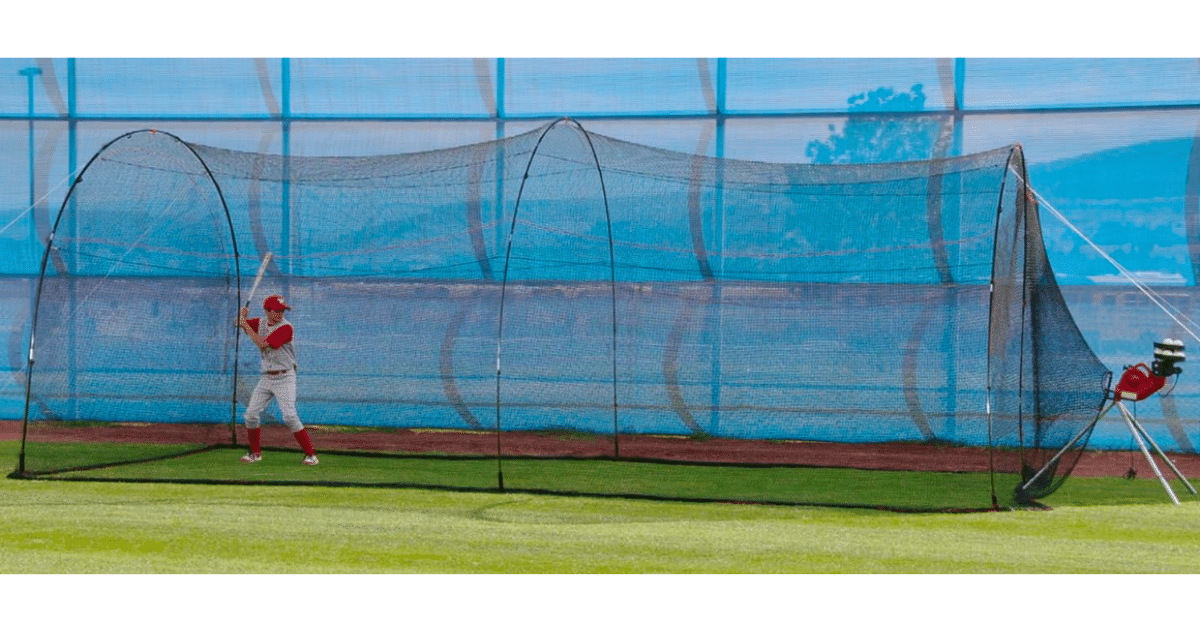What Are The 7 Best Portable Batting Cages For Little League Practice In 2025?
Because your backyard deserves better than broken windows. Ha! I had to toss that one in!
Let’s just say I’ve paid for more than one window thanks to a “perfect” swing gone rogue. That’s when I realized: it’s not just about teaching good mechanics—it’s about protecting your house (and your sanity).
Enter the portable batting cage: your new best friend for backyard training. Whether you’ve got a driveway, small backyard, or full-on Little League setup, these 7 picks will help you turn your space into a personal hitting paradise.
This page contains affiliate links and I earn a commission if you make a purchase through one of the links, at no cost to you. As an Amazon Associate I earn from qualifying purchases.
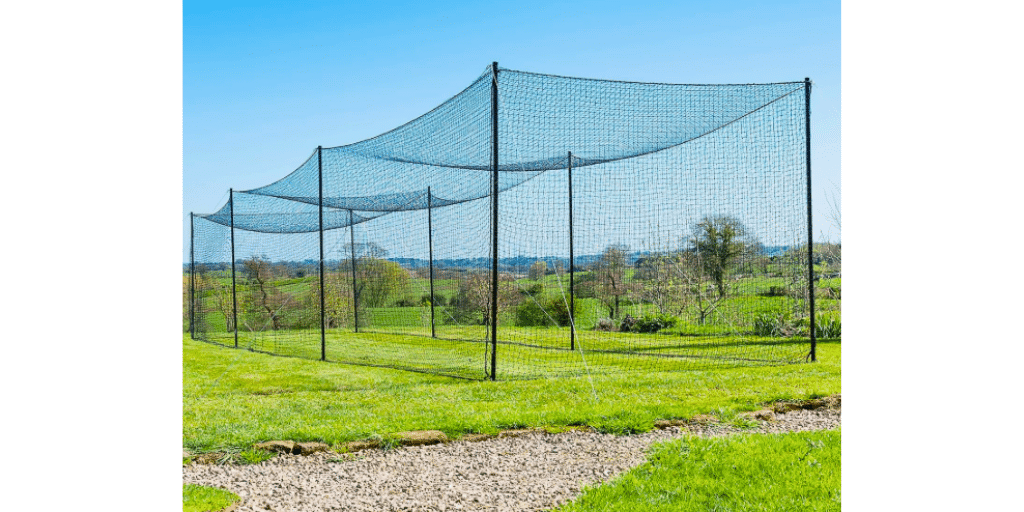
1. Heater Sports PowerAlley Batting Cage
Best for: Budget-conscious beginners
- Why it made the list: Affordable and super compact at 22 feet, this cage is perfect for tight spaces.
- Bonus: Fiberglass poles make setup surprisingly manageable.
- Watch out for: Some users find the netting a bit light-duty for older kids with power swings.
The Heater Sports PowerAlley Batting Cage is a strong option for anyone looking to turn their backyard into a hitting haven.
Designed with both functionality and affordability in mind, it brings pro-style practice right to your home turf—minus the endless ball-chasing and hefty fees of traditional cages.
At 22 feet long, 12 feet wide, and 8 feet high, this cage provides ample room for hitters of all ages, from little sluggers to seasoned adults.
Whether you’re tuning up for Little League or just looking to get in some reps, PowerAlley’s size and setup make it a strong contender for one of the best portable batting cages of 2025.
One of its biggest draws is how it transforms a typical training session.
According to Heater Sports, hitters can jump from hitting 50 pitches per session to 250 with the PowerAlley, thanks to its quick-return setup and hassle-free design.
Built with lightweight fiberglass poles and tough 1 1/4” nylon netting, the cage is both easy to assemble and capable of withstanding everyday use.
Plus, the built-in pitching machine harness allows for a safe, seamless connection to any Heater Sports pitching machine, keeping the operator safely outside the cage.
However, it’s not without flaws.
While many users praise the ease of setup, others have reported challenges with getting the poles and netting properly aligned, particularly for first-timers.
And while the fiberglass frame is lightweight and portable, it’s also been flagged as a weak point—some users noted that the poles cracked or shattered after just a few months, raising durability concerns.
In short, the Heater Sports PowerAlley hits a lot of the right notes for home training.
It’s not bulletproof, but if you treat it right, it just might be the batting cage that transforms your backyard—and your batting average.
Pros and Cons
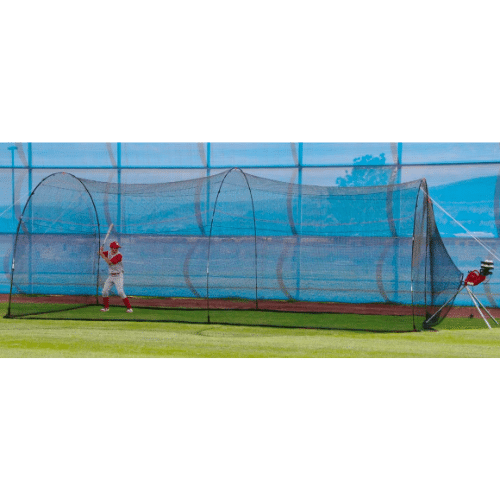
2. FORTRESS Ultimate Baseball Batting Cage
Best for: Serious teams and long-term backyard setups
Watch out for: Bigger cages need more space and may take two adults to assemble.
Why it made the list: This one’s built like a tank—available in sizes up to 70 feet.
Bonus: Heavy-duty netting and galvanized steel frame.
The FORTRESS Ultimate Baseball Batting Cage is built for hitters who aren’t just looking to train—they’re looking to dominate.
This all-in-one batting cage setup combines heavy-duty steel construction with pro-level netting to create a rugged, long-lasting training environment right in your backyard or open space.
With multiple sizes available (20’, 35’, 55’, and 70’), the FORTRESS gives players the freedom to choose the length that matches their swing goals and backyard dimensions.
Where the FORTRESS truly shines is in its materials.
The cage features a UV-treated, rot-proof 2mm knotted twine net with a 48mm mesh—built to handle everything from Little League hacks to full-power swings.
The one-piece net design keeps setup simple while eliminating gaps that can cause stray balls to slip through.
Combine that with black powder-coated 40mm steel poles that are galvanized to fight rust, and you’ve got a batting cage that can brave both the weather and the wear-and-tear of daily use.
Another standout feature?
Flexibility.
With socketed or freestanding options, you can install it permanently or pop it up as needed. It’s easy to transport, relatively straightforward to set up (especially for the smaller sizes), and well-suited for both solo training or team drills.
Customers rave about its durability and quality—especially those who invested in the 35ft version for their young sluggers.
That said, it’s not without hiccups. Some users have noted issues with stability under heavy use.
All in all, the FORTRESS Ultimate Batting Cage lives up to its name—delivering a fortress-like experience that helps players build skills, confidence, and consistency right from home.
Pros and Cons
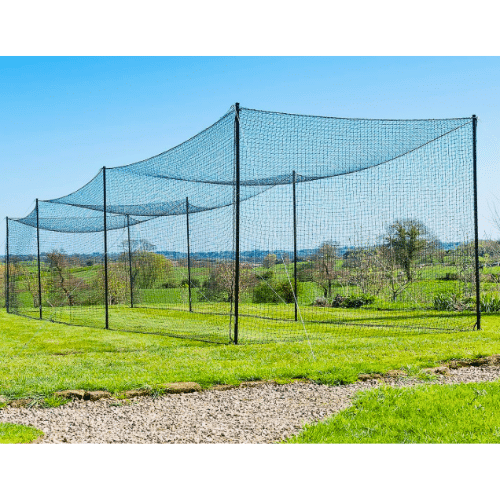
3. Anything Sports Full Batting Cage
Best for: Families who want a real cage experience
- Why it made the list: Durable, flexible frame with pitching machine hole and side access.
- Bonus: Tool-free setup with click-together steel pipes.
- Watch out for: Setup is easier with two people.
The Anything Sports Full Batting Cage is built for ballplayers who want big-league training without ever leaving home.
Measuring 40 feet in length, this all-in-one package includes everything you need to get started: a full steel frame, durable netting, and clear setup instructions.
Whether you’re fine-tuning your swing for the season or just logging extra reps in the backyard, this freestanding, collapsible cage delivers the space and structure you need—without taking over your entire yard.
One of its most praised features is the ease of assembly.
Unlike bulky alternatives, the Anything Sports model can be set up by two people with minimal hassle.
Once it’s standing, it strikes a great balance between portability and high-end performance—ideal for families and coaches who want serious cage time without committing to a permanent structure.
Weighing in at 138 pounds, the cage is sturdy enough for everyday use but still easy to collapse and store when not in use.
Its 40-foot size makes it perfect for structured practices, backyard training, or even light team use.
For those ready to invest in pro-style performance at home, the Anything Sports Full Batting Cage delivers space, quality, and convenience in one thoughtfully engineered package.
Pros and Cons

4. PowerNet Baseball Softball Practice Net
Best for: Coaches on the go
Watch out for: It’s a net, not a full cage—don’t expect full swing protection.
Why it made the list: Portable, lightweight, and perfect for tee work or soft toss.
Bonus: Carry bag included, sets up in under 2 minutes.
The PowerNet 7×7 Baseball & Softball Practice Net is the go-to training tool for players who want to get better without blowing their budget.
This all-in-one training net packs serious value for hitters, pitchers, and fielders alike.
Whether you’re in the backyard, at the park, or indoors, this 7×7-foot net provides 49 square feet of coverage—enough to handle even the hardest swings or wildest pitches.
It’s not just a net; it’s a portable backstop, a pitching target, and a batting cage alternative rolled into one lightweight setup.
Setting it up?
A breeze.
The bow-style fiberglass poles flex into position, and the net assembles in under two minutes—no tools needed.
Ground stakes are included for outdoor stability, and the entire setup collapses into a durable carrying bag with a shoulder strap.
Weighing just 12 pounds, it’s ultra-portable and easy to toss in the trunk, making it perfect for on-the-go training sessions.
Durability is another major win.
Built with a steel base and flexible fiberglass bow poles, the PowerNet can handle serious abuse—from fastballs to line drives to awkward ricochets.
The knotless polyester netting is designed to last through thousands of reps, and customers consistently praise how it holds up over multiple seasons.
It’s no wonder pro players like Corbin Carroll and German Marquez trust PowerNet gear for their own training.
Of course, no product is perfect.
While the net is sturdy for its weight, it’s still a lightweight setup—so it may wobble slightly in windy conditions if not staked down.
And although the carry bag is a great inclusion, some users wish it had a bit more padding for long-term storage.
Still, for the price, performance, and convenience, the PowerNet 7×7 Practice Net is one of the best-value training tools on the market today.
Pros and Cons
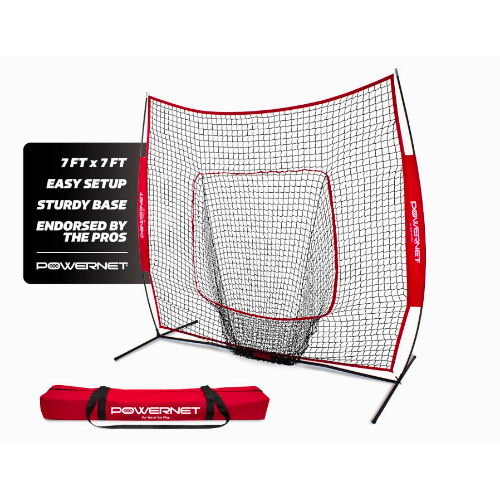
5. Handson Slider Lite-BB and Xtender 24 ft. Cage
Best for: Younger kids who want it all in one
- Why it made the list: Combo of pitching machine + cage = instant training zone.
- Bonus: Fun, adjustable-speed lite ball machine.
- Watch out for: Only works with lite balls, not real baseballs.
The Handson Slider Lite-BB and Xtender 24 ft. Cage is a complete at-home batting system built for players who want to sharpen their hitting skills.
This all-in-one setup includes the Slider Lite-Ball Pitching Machine—which delivers fastballs and breaking balls at variable speeds up to 60 MPH—and the Xtender 24-foot Batting Cage, engineered with a smart combo of strength and flexibility.
It’s a great pick for anyone looking to bring structured, consistent batting practice right into their backyard.
The cage design is what really sets this system apart.
The side supports are constructed from sturdy steel tubing, while the center arch uses a fiberglass rod, giving the cage both strength and bendable flexibility—especially useful in wind.
Add in six power ground stakes and rugged foam padding around the supports, and you’ve got a stable, protected frame built to withstand high reps and big swings.
The real bonus?
The 1-inch netting is tighter and stronger than the 2-inch standard, offering improved ball containment and durability—and it’s even fine enough to double as a golf cage.
The Slider Lite-BB pitching machine is fully electric and plugs into any standard wall outlet.
It includes a 12-ball automatic feeder that drops balls every 9 seconds, which means hitters can take swings solo without relying on a coach or parent to feed balls.
With a simple swivel adjustment, you can alternate between fastballs and curveballs, adding variety to every training session.
The pitch height is adjustable, and the feeder and enclosed wheel design make it safe and reliable for home use.
Still, it’s not without tradeoffs.
While the net and machine combo deliver serious value at this price point, the setup is designed for lite-balls only, meaning it won’t accommodate standard baseballs.
And although the cage is extendable, some users may find the initial 24-foot length limiting for older players with longer swing paths or higher velocity needs.
That said, for under $500, the Slider Lite-BB and Xtender 24 ft. Cage is a valuable training tool.
Pros and Cons
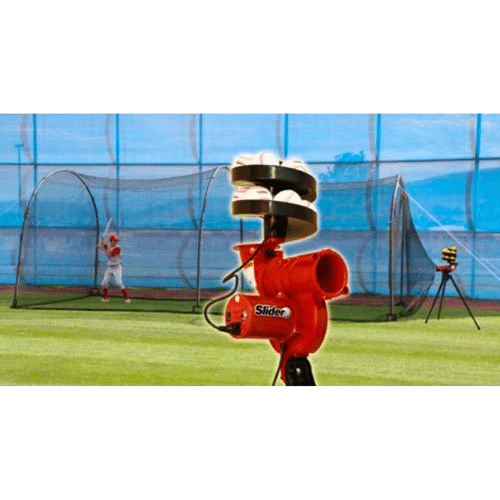
6. Murray Sporting Goods Baseball/Softball Batting Cage
Best for: Little Leaguers with big swings
- Why it made the list: Solid 40-foot option with weather-resistant netting.
- Bonus: Great price point for its size.
- Watch out for: Frame may flex slightly with heavy use.
The Murray Sporting Goods Baseball/Softball Batting Cage is a powerhouse option for players looking to bring a full-scale training setup into their own backyard.
Measuring 40 feet long, 10 feet wide, and 10 feet tall, this cage provides ample space for hitters of all ages to take swings without feeling cramped.
Whether you’re in Little League or older, the heavy-duty black steel frame and 60-ply weather-resistant netting make it a durable, long-term investment that can handle season after season of practice.
From casual backyard reps to serious pre-game warmups, this cage does it all.
What really makes the Murray cage stand out is its smart, user-friendly design.
A large 7-foot entrance door unzips the full length of one end, making it easy to wheel in gear like an L-screen, pitching machine, or turf mat.
On the opposite side, a dedicated 4-foot pitching machine hole allows a feeder to stay safely outside the cage while keeping the machine locked in position.
It’s the kind of practical feature you don’t realize you need until you’ve used it—and now can’t live without.
The net also offers excellent visibility, so you can easily track balls and monitor swing progress during your session.
Setup is straightforward and designed with efficiency in mind.
The labeled metal poles snap together with a secure click, and with two people, you can have the entire cage standing in a reasonable amount of time.
Ground stakes and extra bungee cords are included for added wind resistance, while water-drainage holes at the bottom of each support leg help prevent rust or water buildup after rainy days.
This makes it one of the few cages in its class that’s both structurally solid and weather-aware—something any outdoor hitter will appreciate.
Of course, all that strength and structure comes with a couple of trade-offs.
At nearly $800, this cage delivers serious value—but may stretch the budget for casual users.
And although setup is fairly intuitive, you’ll definitely need a second set of hands and a bit of time to get it done right.
Still, if you’re ready to level up your batting practice and want a cage that can take a beating and look good doing it, the Murray Sporting Goods Batting Cage delivers on performance, durability, and smart design.
Pros and Cons
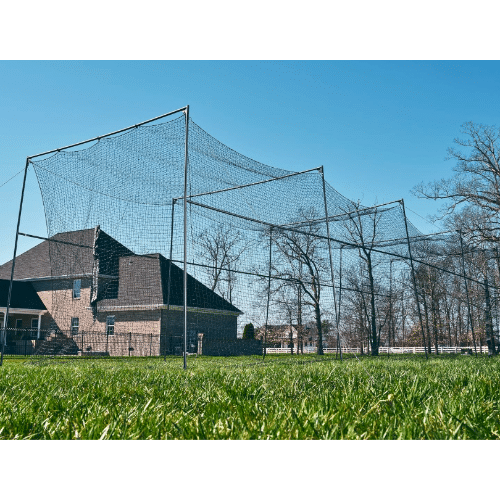
7. Jugs Hit at Home Backyard Batting Cage
Best for: Players who want the best and have space for it
- Why it made the list: Big, pro-style cage with plenty of room to train.
- Bonus: Trusted Jugs quality and a full 45 feet of length.
- Watch out for: Premium price—but premium performance.
The JUGS Hit at Home Backyard Batting Cage is a premium backyard setup designed for players who want pro-level practice in a compact space.
Measuring 45 feet long by 11 feet wide and 11 feet high, it’s built to fit comfortably in most backyards or tight hitting zones—without sacrificing the feel of a real cage.
Whether you’re working on tee drills, short toss, soft toss, or full-on machine pitching, this cage has the structure and space to support it all.
And the best part? It comes as a complete package—net, frame, stakes, guy-wires, hangers, and hardware all included.
The frame combines powder-coated steel tubing with double-staked, vision-enhanced guy wires to deliver the kind of weather-resistant durability you need for daily backyard use.
The #27 twisted knotted polyethylene netting is hung square for enhanced strength and better ball absorption, making it ideal for repeated impact.
It even includes a built-in JUGS Hitter’s Door for easy walk-in/walk-out access, eliminating the need for awkward entries and exits.
From design to materials, every detail is crafted with performance and longevity in mind.
Setup is surprisingly user-friendly.
Despite its pro-level specs, the cage doesn’t require any permanent construction.
With two people, you can have it up in under an hour.
And when it’s time to store or move it?
Just unhook the turnbuckles, and the entire structure lowers to the ground.
This collapsible functionality, combined with the sturdy design, gives users the best of both worlds: reliable performance and flexible placement.
That said, the JUGS Hit at Home cage is an investment—priced over $1,000, it’s best suited for dedicated players or families committed to long-term development.
And while setup is relatively quick, it still requires two people and some muscle, especially when anchoring the cables and tensioning the frame.
But for those looking to build a serious backyard training space, the JUGS cage delivers pro-quality performance in a smart, compact design.
Pros and Cons
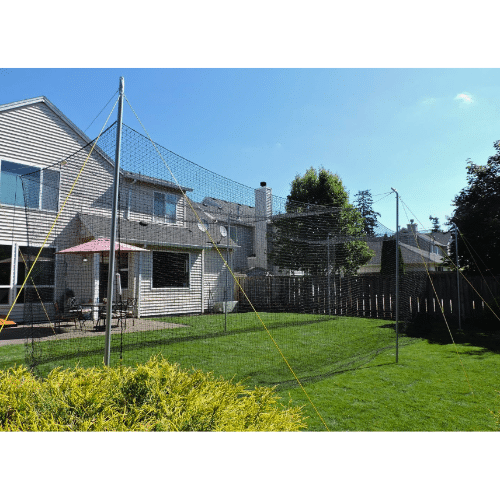
Frequently Asked Questions
Are portable batting cages safe for backyard use?
Yes—when properly secured with stakes or weights, these cages are designed for safe at-home use. Always supervise younger players and avoid using real baseballs with lite-ball cages.
What size batting cage is best for Little League players?
Anywhere from 22 to 45 feet works well depending on space. A 40-foot cage offers a great balance of realism and yard-friendliness.
Can these cages be used with real baseballs?
Most full-frame cages can handle real baseballs, but models like the Heater Slider Lite-Ball are designed for lite balls only. Check each listing for ball compatibility.
How hard are these batting cages to assemble?
Most require 1–2 people and can be set up in under an hour. Anything with steel poles or longer lengths (like the 60- or 70-foot cages) might take a little more elbow grease.
Can I use a pitching machine with these cages?
Yes! Many of these cages are compatible with pitching machines. Some even include machine slots built into the design.
How should I store the cage in the off-season?
Disassemble and store it in a dry area. Make sure the net is clean and dry to prevent mold or degradation.
7 Best Portable Batting Cages for Little League Practice In 2025
Final Thoughts
Let’s be honest—batting cages aren’t exactly impulse buys.
But if you’re tired of chasing balls around the yard or shelling out for cage time every weekend, owning one might just be your best swing yet.
We’ve rounded up a variety of options—from budget-friendly practice nets to full-on backyard training setups.
Whatever your price point or space, there’s a cage here that’ll help you (or your little slugger) get more reps, more rhythm, and way more confidence at the plate.
Whether you’re swinging for the fences or just getting started, the right batting cage can change everything. Click through the options above, find the one that fits your field—and start taking more productive cuts today.

